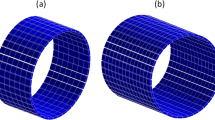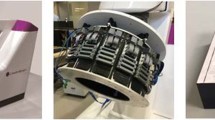Abstract
Purpose
Molecular imaging, particularly PET scanning, has become an important cancer diagnostic tool. Whole-body PET is not effective for local staging of cancer because of their declining efficiency in detecting small lesions. The preliminary results of the performance evaluation of designed dedicated breast PET scanner presented.
Methods and materials
A new scanner is based on LYSO crystals coupled with SiPM, and it consists of 14 compact modules with a transaxial FOV of 180 mm in diameter. In this study, initial GATE simulation studies were performed to predict the spatial resolution, absolute sensitivity, noise equivalent count rate (NECR) and scatter fraction (SF) of the new design. Spatial wobbling acquisitions were also implemented. Finally, the obtained projections were reconstructed using analytical and iterative algorithms.
Results
The simulation results indicate that absolute sensitivity is 1.42% which is appropriate than other commercial breast PET systems. The calculated SF and NECR in our design are 20.6% and 21.8 kcps. The initial simulation results demonstrate the potential of this design for breast cancer detection. A small wobble motion to improve spatial resolution and contrast.
Conclusion
The performance of the dedicated breast PET scanner is considered to be reasonable enough to support its use in breast cancer imaging.









Similar content being viewed by others
References
Rajaraman P, Anderson BO, Basu P, Belinson JL, D'Cruz A, Dhillon PK, et al. Recommendations for screening and early detection of common cancers in India. Lancet Oncol. 2015;16(7):e352–e361361.
Stewart B, Wild CP. World cancer report 2014. Health. 2017.
Berg WA, Bandos AI, Mendelson EB, Lehrer D, Jong RA, Pisano ED. Ultrasound as the primary screening test for breast cancer: analysis from ACRIN 6666. JNCI J Natl Cancer Inst. 2016;108(4):djv367.
Lehman CD, Lee JM, DeMartini WB, Hippe DS, Rendi MH, Kalish G, et al. Screening MRI in women with a personal history of breast cancer. J Natl Cancer Inst. 2016;108(3):djv349.
Peters NH, Borel Rinkes IH, Zuithoff NP, Mali WP, Moons KG, Peeters PH. Meta-analysis of MR imaging in the diagnosis of breast lesions. Radiology. 2008;246(1):116–24.
Haas BM, Kalra V, Geisel J, Raghu M, Durand M, Philpotts LE. Comparison of tomosynthesis plus digital mammography and digital mammography alone for breast cancer screening. Radiology. 2013;269(3):694–700.
Granov A, Tiutin L, Schwarz T. Positron emission tomography. Berlin: Springer Science & Business Media; 2013.
Madsen M. Quantitative analysis in nuclear medicine imaging. Med Phys. 2007;34(4):1522.
Fowler AM. A molecular approach to breast imaging. J Nucl Med. 2014;55(2):177–80.
Groheux D, Espié M, Giacchetti S, Hindié E. Performance of FDG PET/CT in the clinical management of breast cancer. Radiology. 2013;266(2):388–405.
Thompson C, Murthy K, Weinberg I, Mako F. Feasibility study for positron emission mammography. Med Phys. 1994;21(4):529–38.
Belcari N, Guerra A. High-resolution and animal imaging instrumentation and techniques. Handbook of particle detection and imaging. Berlin: Springer; 2012. p. 1125–1151.
MacDonald L, Edwards J, Lewellen T, Haseley D, Rogers J, Kinahan P. Clinical imaging characteristics of the positron emission mammography camera: PEM Flex Solo II. J Nucl Med. 2009;50(10):1666–755.
Raylman RR, Majewski S, Smith MF, Proffitt J, Hammond W, Srinivasan A, et al. The positron emission mammography/tomography breast imaging and biopsy system (PEM/PET): design, construction and phantom-based measurements. Phys Med Biol. 2008;53(3):637.
Bowen SL, Wu Y, Chaudhari AJ, Fu L, Packard NJ, Burkett GW, et al. Initial characterization of a dedicated breast PET/CT scanner during human imaging. J Nucl Med Off Publ Soc Nucl Med. 2009;50(9):1401.
Godinez F, Chaudhari AJ, Yang Y, Farrell R, Badawi RD. Characterization of a high-resolution hybrid DOI detector for a dedicated breast PET/CT scanner. Phys Med Biol. 2012;57(11):3435.
Moliner L, Gonzalez A, Soriano A, Sánchez F, Correcher C, Orero A, et al. Design and evaluation of the MAMMI dedicated breast PET. Med Phys. 2012;39(9):5393–404.
Miyake KK, Matsumoto K, Inoue M, Nakamoto Y, Kanao S, Oishi T, et al. Performance evaluation of a new dedicated breast PET scanner using NEMA NU4-2008 standards. J Nucl Med. 2014;55(7):1198–203.
Brooks RA, Sank VJ, Di GC, Friauf WS, Leighton SB. Design of a high resolution positron emission tomograph: the Neuro-PET. J Comput Assist Tomogr. 1980;4(1):5–13.
Bohm C, Eriksson L, Bergstrom M, Litton J, Sundman R, Singh M. A computer assisted ringdector positron camera system for reconstruction tomography of the brain. IEEE Trans Nucl Sci. 1978;25(1):624–37.
Cho Z-H, Son Y-D, Kim H-K, Kwon D-H, Joo Y-H, Ra JB, et al. Development of positron emission tomography with wobbling and zooming for high sensitivity and high-resolution molecular imaging. IEEE Trans Med Imaging. 2019;38(12):2875–82.
Salar S, Navid Z, Mohsen T, Sanaz K, Hadi K, Saeed S, et al. Generic high resolution PET detector block using 12 × 12 SiPM array. Biomed Phys Eng Express. 2018;4(3):035014.
Association N. NEMA Standards Publication NU 4-2008. Performance measurements of small animal positron emission tomographs. 2008.
Conti PS, Lilien DL, Hawley K, Keppler J, Grafton ST, Bading JR. PET and [18 F]-FDG in oncology: a clinical update. Nucl Med Biol. 1996;23(6):717–35.
Geramifar P, Ay M, Zafarghandi MS, Sarkar S, Loudos G, Rahmim A. Investigation of time-of-flight benefits in an LYSO-based PET/CT scanner: a Monte Carlo study using GATE. Nucl Instrum Methods Phys Res Sect A. 2011;641(1):121–7.
Moliner L, Gonzalez A, Soriano A, Sanchez F, Correcher C, Orero A, et al. Design and evaluation of the MAMMI dedicated breast PET. Med Phys. 2012;39(9):5393–404.
Author information
Authors and Affiliations
Corresponding authors
Additional information
Publisher's Note
Springer Nature remains neutral with regard to jurisdictional claims in published maps and institutional affiliations.
About this article
Cite this article
Emami, A., Ghadiri, H., Ghafarian, P. et al. Performance evaluation of developed dedicated breast PET scanner and improvement of the spatial resolution by wobbling: a Monte Carlo study. Jpn J Radiol 38, 790–799 (2020). https://doi.org/10.1007/s11604-020-00966-w
Received:
Accepted:
Published:
Issue Date:
DOI: https://doi.org/10.1007/s11604-020-00966-w




